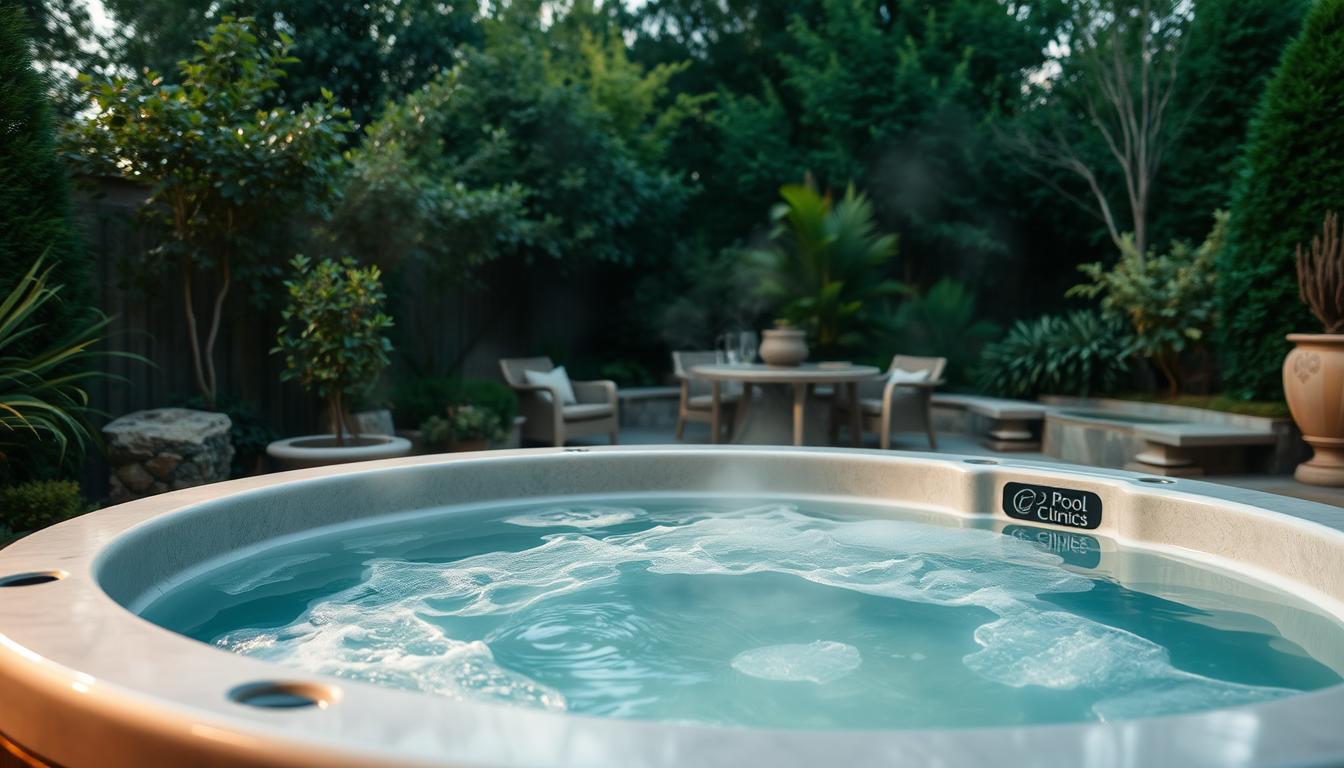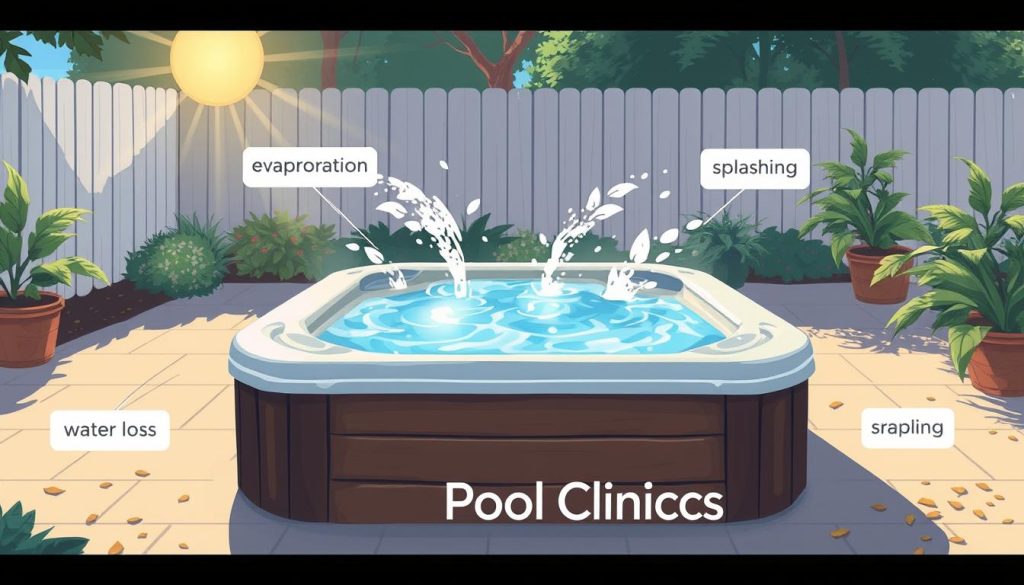
Imagine this: you’re ready for a relaxing soak in your hot tub. But the water level has dropped since last time. Don’t panic! Your hot tub may not have a leak at all.
Water loss in hot tubs is a common issue. It can be puzzling, but there are several reasons for it. Understanding these factors helps maintain proper water levels and ensures your spa’s longevity.
Let’s explore why your hot tub might be losing water without a leak. We’ll cover causes like evaporation, splashing, and overflow. You’ll also find practical tips to troubleshoot and fix the issue.
Key Takeaways
- Hot tub water loss can occur without a leak due to factors like evaporation, splashing, and overflow.
- Identifying the root cause of water loss is crucial for maintaining proper water levels and hot tub longevity.
- Performing a hot tub leak test can help determine if a leak is present.
- Regular hot tub maintenance, including checking for leaks and balancing water chemistry, can prevent water loss issues.
- Simple DIY fixes can often resolve minor water loss problems, but professional help may be needed for more complex issues.
Common Causes of Hot Tub Water Loss
Is your hot tub losing water without visible leaks? Don’t worry. Several common causes exist that aren’t structural or plumbing issues. Understanding these can help you solve the problem and maintain your spa’s performance.

Evaporation
Evaporation is a primary cause of hot tub water loss. Heated water naturally turns to vapor, decreasing water levels over time. Factors like temperature, humidity, and wind affect evaporation rates.
Hot tubs can lose 1-2 inches weekly from evaporation alone. Use a well-fitting cover when not in use to reduce this. Also, maintain proper water chemistry to minimize frequent heating.
Splashing and Overflow
Water loss often occurs from splashing and overflow. People entering, exiting, or playing can cause noticeable water decrease. High water levels may lead to overflow, especially when jets run or multiple people use it.
Keep water at the recommended level to prevent excess loss. Encourage users to enter and exit the tub carefully.
Leaking Pipes and Fittings
Leaking pipes and fittings can contribute to water loss. Over time, plumbing parts may crack or loosen, allowing water to escape. Leaks can occur in pumps, heaters, valves, or jets.
Regularly inspect your hot tub’s components for leaks. Look for wet areas around the base, reduced jet pressure, and rapidly declining water levels. Address issues promptly to prevent damage.
| Cause | Description | Prevention |
|---|---|---|
| Evaporation | Natural process of water turning into vapor due to heating | Use a well-fitting cover and maintain proper water chemistry |
| Splashing and Overflow | Water loss due to activities like playing, exercising, or high water level | Maintain recommended water level and encourage careful entry/exit |
| Leaking Pipes and Fittings | Water escaping through deteriorated or damaged plumbing components | Regularly inspect and address any issues with pipes, valves, or jets |
Troubleshooting Your Hot Tub’s Water Loss
Is your hot tub losing water? Quick action can prevent damage to your spa. A hot tub leak test and component inspection can help identify the problem’s source.
Performing a Hot Tub Leak Test
Start by marking the current water level. Turn off the hot tub and let it sit for 24 hours. Check the water level again after the designated time.
A significant drop (more than an inch) likely indicates a leak. Some water loss due to evaporation is normal. Factors like humidity, temperature, and use frequency can affect this.
Inspecting Hot Tub Components for Leaks
If you’ve confirmed a leak, inspect various components for damage or wear. Common areas to check include:
- Pump
- Heater
- Pipes and fittings
- Valves
- Jets
- Shell
Look for visible cracks, rust, or pooling water around these components. Pay attention to pipe and fitting connections. These are prone to leaks over time.
Address any damage promptly to prevent further water loss. This will help protect your hot tub from potential harm.
According to industry statistics, water-related issues are the number one problem in hot tub repair, with pumps costing up to $1,000 or more to replace and leaks occurring due to tubing issues or freezing in cold climates.
A thorough inspection helps identify the leak source. This allows you to take necessary repair steps. You can then restore your spa to its best condition.
| Component | Potential Leak Causes | Inspection Tips |
|---|---|---|
| Pump | Worn seals, damaged impeller | Check for pooling water, unusual noises |
| Heater | Cracked housing, loose connections | Look for rust, mineral buildup |
| Pipes and Fittings | Loose connections, cracks | Inspect for visible damage, leaks |
| Valves | Worn gaskets, damaged diverter valves | Check for leaks, difficulty turning |
| Jets | Cracked housings, loose connections | Look for cracks, leaks around the base |
| Shell | Cracks, punctures | Inspect for visible damage, leaks |
Fixing Hot Tub Water Loss
It’s crucial to act fast when your hot tub loses water. Quick action prevents further damage and keeps your tub in top shape. Let’s explore how to fix this issue effectively.
Identifying Hidden Leaks
Sometimes, leaks hide in the plumbing or shell. Food coloring can help find these tricky spots. Add a few dye drops to the water and watch where it goes.
This method works great for hard-to-see areas. It can reveal leaks that a visual check might miss.
DIY Hot Tub Leak Repair Tips
Minor leaks often come from loose fittings or worn gaskets. You can fix these yourself with some simple tools. Try tightening unions with channel locks or replacing rubber washers.
For small cracks, use waterproof adhesives or sealing patches. These can effectively repair minor shell damage.
According to industry statistics, around 10% of hot tubs experience leakage, commonly due to a torn or punctured liner.
Be careful with major repairs, though. Attempting these without proper knowledge can make things worse. When in doubt, call an expert.
When to Call a Professional
For big leaks or electrical issues, always call a pro. It’s safer and more effective. Here are some situations that need expert help:
- The leak is severe and causing significant water loss
- The leak involves electrical components, posing a safety risk
- DIY repair attempts have been unsuccessful
- The hot tub is under warranty, and self-repair may void the warranty
Pros have the right tools and know-how to fix major problems. They can also check your tub’s overall health and prevent future issues.
| Repair Scenario | DIY or Professional? |
|---|---|
| Minor leaks (loose fittings, worn gaskets) | DIY repair possible |
| Major leaks | Professional repair recommended |
| Leaks involving electrical components | Professional repair essential for safety |
| Hot tub under warranty | Check warranty terms; professional repair may be required |
Spot leak signs early and take action. This protects your investment and keeps your hot tub enjoyable. With proper care, your tub will remain a relaxing oasis for years.
Conclusion
Hot tub water loss can be frustrating. Understanding the causes and troubleshooting can help maintain proper water levels. Hot tub maintenance is crucial for preventing hot tub water loss. Regular checks for leaks and balanced water chemistry are essential.
Millennium Pools & Spas, with 35 years of experience, stress the importance of clean filters. This maintains water quality and system efficiency, especially during heavy use periods.
Water loss over 1/2″ daily requires investigation. The bucket test compares water levels inside and outside a bucket. This helps determine if the loss is due to evaporation or a leak.
If the loss is below 1/2″ after 24 hours, it’s likely environmental. Pool contractors suggest ruling out splash out, wind, humidity, and backwash before leak diagnostics.
Follow these hot tub care tips to handle water loss issues. Observe where water stabilizes to find potential leaks. Check for wet spots to identify equipment-related leaks.
Run the spa for 30 minutes to isolate leaks. Prevention is key in hot tub maintenance. Address issues promptly to ensure your spa remains enjoyable for years.







